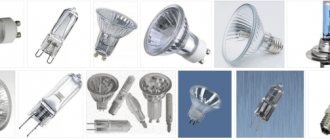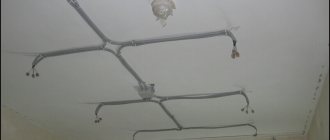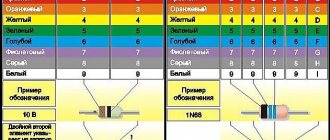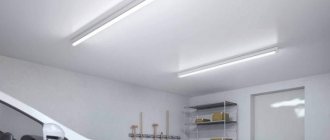TYPES OF LAMP CHARACTERISTICS
Artificial electric lighting systems are used in all spheres of human activity.
These are complex multi-component engineering systems in which the end user comes into contact with only a small part of the electrical equipment.
They include the following elements:
Electricity generating capacities.
Global (hydroelectric power plants, thermal power plants, nuclear power plants) - provides the entire energy consumption structure of the region. Local (solar panel systems and wind generators of various capacities) - provide additional energy supply for one individual object.
This could be a residential building, a manufacturing facility or a commercial organization.
Electricity transmission system.
Overhead power lines or cable networks.
Converters.
Various transformers, convectors and rectifiers that transform the parameters of electric current from transport to consumer.
Electric power distribution devices.
Open and closed type (ORU, ZRU).
Protective equipment.
As a rule, these are relay protection circuits, which may include the following components: resistance, current and voltage relays, arc and lightning protection devices, as well as short circuit protection.
Control equipment.
Household electric meters and various automated systems for monitoring and accounting for commercial electricity consumption.
Operation and consumption devices.
This section includes all end user equipment, including lighting systems.
If you look at the lighting system from the consumer's point of view, it will consist of the following components. First of all, these are sources of artificial electric lighting (various lamps, fixtures, sconces, spotlights, etc.) and control equipment - switches.
An equally important element is electrical wiring, which may include transformers, connecting and terminal devices.
Electrical wiring can be low or high voltage. Low-voltage alternating current 12V and 24V is obtained using step-down transformers. The need for low-voltage power grids arises at enterprises that use appropriate lighting equipment (usually imported).
Everywhere in the Russian Federation, the standard for high-voltage lighting equipment has been adopted - 220V. Consumer conductive systems used for lighting have current limitations.
In low-voltage electrical systems, it does not exceed 25A; accordingly, the total power consumption is limited to 300 W at a voltage of 12 Volts. In practice, such an electric artificial lighting system is sufficient to supply power to only 9 halogen lamps with a power of 30 W each.
This is one of the main arguments in favor of the operation of high-voltage systems, in which the current value is 15A and the electrical power is 3.5 kW.
If the total power of all installed lamps exceeds the permissible value, then the lighting systems are divided into several autonomous subsystems, connecting each of the electrical networks to a separate transformer and/or RCD (residual current device).
What is natural light
Natural light is the rays of the sun penetrating into a room. Such flows are comfortable for the eyes and fill the rooms with an atmosphere of comfort.
To “let in” more light into the premises, professionals study the design features of buildings and try to take into account all factors. It is important to know how natural lighting systems are divided. Conventionally, three types can be distinguished:
- Top: Sun rays stream into rooms from openings in the roof. However, this option is only possible for one-story buildings.
- Lateral: flows enter the premises through openings in the walls of the building, that is, through windows. This is the most common way to illuminate rooms.
- Combined: rays fall from both above and from the side. The optimal lighting option, but implemented only in one-story buildings or on the upper floors of multi-story buildings.
The level of natural light can vary significantly even during daylight hours. Ideally, the windows in the room are located on two opposite walls. In this case, there is a chance to catch more sunlight, even if external factors interfere.
Overhead natural lighting of the room
Option for combined natural lighting in the apartment
Lateral natural light through the skylight
Option for side natural lighting through long narrow windows
Important! If there are trees or tall buildings in front of the house, the sun's rays will have difficulty penetrating into the premises. In this case, the problem will have to be solved with the help of artificial lighting.
Who is a lighting designer and why is one needed?
It is very difficult to think through a lighting strategy on your own without special skills. At first glance, the task seems feasible, but in practice it is rarely possible to correctly implement ideas. Common mistakes:
- Incorrect placement of lamps.
- Failure to comply with lighting standards.
- Inefficient distribution of sockets and switches.
- Lack of a plan for linking lamps to switching groups.
It is also important to understand the types of lighting and the characteristics of electrical appliances. In order not to delve into these issues, it is easier to trust a professional.
The main task of a lighting designer is to properly organize lighting. A specialist must be familiar with colors, interior styles, lighting equipment, and fashion trends. When developing the project, he is also guided by the climatic nuances of the region.
The first stage of a specialist’s work is creating a concept. The lighting designer evaluates the characteristics of natural lighting, plans the location of lamps, and considers the type and number of devices.
A professional knows how to complete the job in accordance with norms and standards. It will help organize designer lighting that will bring comfort to all occupants of the rooms.
An example of successful room lighting design
Natural light for a comfortable life
Human health and mood directly depend on the quality of lighting. Everything plays a role: the direction of light, color rendering, the number of light fluxes. Therefore, professionals have provided several rules on which builders of modern buildings rely. Primary requirements:
- The distance between windows should not exceed one and a half meters.
- The premises must be designed so that all rooms receive direct sunlight for at least 2.5 hours a day.
- The optimal size of one window is 1/5 of the area of the room.
- The higher the ceilings in the building, the higher the windows should be located from the floor.
If there are several rooms in a house or apartment, at least 60% of them should be well lit. Depending on the level of natural light, it is necessary to consider the purpose of the premises. The greater the attendance, the more light there should be.
Natural lighting in the apartment
Shower and toilet
The role of lighting in the interior is especially evident in rooms where sunlight often does not reach. For lighting you should use spots, sconces or a small chandelier.
If there is a mirror in the room, then it can also be equipped with additional lighting sources. For example, you can use LED strip or spots with low power.
In addition to the mirror, you can use lighting for the rack, bathtub and other objects on which you would like to focus. White or light yellow lighting in the interior looks especially relevant; it adds elegance and luxury to natural materials such as stone, wood or metal.
Since the devices are placed in a room with a high level of humidity, it is important to take this factor into account. It is worth insulating the wires as much as possible and choosing moisture-resistant materials to avoid problems.
Advantages of natural lighting over artificial
You already know what natural room lighting is. It remains to figure out what its advantages are over artificial ones. Here are a few factors:
- The sun's rays do not flicker, so they do not add strain to your eyesight.
- Effective use of natural light can reduce energy costs by 60-80%.
- Natural flows are perceived without color distortion.
However, you cannot do without artificial light sources, because the sun's rays disappear in the evening. In the afternoon, the rooms will become brighter thanks to properly selected lamps.
Even more modern lighting ideas in the photo
Here we will look at some interesting ideas for lighting an apartment.
Concept and main types of artificial lighting
Artificial lighting of rooms is achieved with the help of lighting devices: chandeliers, floor lamps, lamps, sconces and many others. To create a comfortable atmosphere in the room, experts carefully plan the layout of the elements. There are three types of lighting:
- General (upper, central): lighting fixtures are located along the perimeter of the ceiling. Artificial rays are evenly scattered throughout the room.
- Local (zonal, working): additional light sources are located in those areas where enhanced illumination is needed. For example, at the kitchen or work table.
- Decorative: they highlight interior items with light in order to present them in a more advantageous position.
Typically, combined lighting is organized in residential premises - a combination of general and local. This scheme allows you to concentrate light fluxes in all corners of the room.
Ceiling artificial lighting
Local artificial lighting with wall lamps
Combined artificial lighting in the room
Creative artificial lighting in the room
Kitchen and dining group
Many people are interested in the question of what is the role and purpose of lighting in various rooms. The kitchen and dining room should also be equipped with a lighting system. This is necessary for comfort and aesthetic harmony.
If you plan to install lamps directly above the surface of the tabletop, then their height should be approximately 60 centimeters. This replacement of artificial lighting is very convenient, as it creates maximum comfort for cooking.
For small rooms it is worth using point systems, as chandeliers can overload the interior. Elegant lamps made of natural wood or metal are perfect for the kitchen.
Decorative light in the interior
Decorative lighting does not carry a special functional load, but it creates a unique atmosphere in the room. Options for implementing the idea:
- Retro lamps are lighting devices decorated in original glass bulbs with an antique design. They can be placed both on the ceiling and on the walls. A hanging “bouquet” of such lamps looks especially impressive.
- LED strip is a decorative light element that is often used for contour lighting of objects and structures. You can select a specific shade of light and adjust the brightness of the streams.
- Garlands are a design of small light bulbs emitting monochromatic or colored streams. Many are accustomed to using such devices as holiday decorations, but they may well take a permanent place in the interior.
- Neon elements are light compositions made from curved tubes filled with gas. This decor looks amazing against the background of dark wall decoration.
- LED lighting for mirrors and paintings are special lamps that are attached directly to decorative elements. They emit soft currents, making the accessories stand out in the interior.
If you think through the composition wisely, creative lighting will add zest to the interior of the rooms. You can turn the ideas of creating light elements with your own hands into reality. You will get a unique design that no one else will have.
Creative artificial lighting with garland
Creative artificial lighting with retro lamps
Creative artificial lighting with LED strip
Creative artificial lighting neon element
Methods of lighting in the apartment
Thanks to modern technologies and the development of design trends, a wide variety of types of lighting in the interior are presented for arrangement. So, you can choose the following varieties:
- Bright system - chandeliers, spots in sufficient quantity.
- Subdued light for an evening or romantic setting - sconces, medium-power lamps, floor lamps, hidden lighting, small amounts of spots.
- A system with an accent design for zoning or highlighting any interior item - directional light.
- Festive system with decorative elements, LED strips, garlands.
It looks good to use not just one lamp, but an entire system. This way you can create all four types of modern lighting at the same time.
Note! Each device requires a separate switch. Modern design requires their maximum camouflage, and a large number of controls can disrupt the overall composition.
When carrying out renovations or construction, before decorating the interior, it is important to think through and place the wiring.
How are the standards for natural and artificial lighting determined?
You cannot plan a lighting scheme by eye. The work requires preliminary calculations and correlation with key factors: climate, type of building, ceiling height, room dimensions. We propose to study how natural and artificial lighting is regulated.
Methods for proper planning of natural lighting
When making calculations, you should be guided by SNiP 23-05-95. First you need to understand what the natural light factor KEO is. This is the percentage ratio of the light fluxes created at a certain point on a given plane inside the room to the horizontal illumination due to the completely open sky. There is a special form for calculating indicators.
It is important to evaluate the size of window openings, the type of glazing, and the ability of window glass to transmit sunlight. The climatic region where the building is located also plays a role. How is natural light regulated taking into account these factors:
eN = en*m
Let's decipher:
- en is the KEO indicator determined by the formula.
- m is the light climate coefficient in the area where the house is located.
You can determine the indicators using a professional device - a lux meter. This method allows you to get the most accurate result, which is why specialists often choose it.
Types of lighting equipment
Lighting equipment can be lanterns, lamps, various lamps, and spotlights.
Lighting devices can vary in the effect they produce:
- spot lighting (directional lighting);
- blurry lighting (scattered light);
- creating various lighting effects.
Professional lighting instruments include:
- color changers;
- scanners;
- rotating heads;
- gobo spotlights;
- anti-aircraft searchlights;
- lasers;
- LEDs. Read about the use of LED lighting here.











